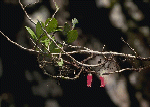16. Oreanthes BENTHAM Pl. Hartweg. 140 (1844). -- Type: Oreanthes buxifolius
BENTHAM.
Reference: LUTEYN, J. L., Notes on neotropical Vaccinieae (Ericaceae). IV. A review
of the genus Oreanthes.
Brittonia 29(2): 173--176 (1977).

Terrestrial or epiphytic shrubs, often trailing subshrubs; indumentum (when present)
of simple or multicellular, glandular hairs. Leaves alternate, thick-coriaceous
and usually succulent when fresh, usually obscurely 3 (-5--7)-plinerved, short-petiolate. Inflorescence axillary, of solitary or paired flowers, rarely with up to 3 flowers
in a fascicle; floral bract and bracteoles minute, often caducous. Flowers 5-merous,
without odor; aestivation valvate; calyx continuous with pedicel; hypanthium terete to bluntly 5-angled, glabrous to glandular pubescent; corolla cylindric, terete
to angled, red to scarlet, glabrous to glandular pubescent; stamen 5 or 10, equal,
nearly as long as corolla, rarely longer; filaments distinct or connate, shorter
than the anthers, lacking spurs; anthers lacking disintegration tissue; thecae essentially
smooth; tubules slightly longer to up to 6 times longer and about 1/2 the width
of the thecae, dehiscing by terminal or subterminal and oblique, usually slightly
flaring pores, rarely elongate clefts; pollen lacking viscin threads; ovary inferior;
style slightly exserted; nectariferous disk usually obscure or rarely annular-pulvinate.
Fruit a berry.
A genus of 7 species, endemic to Ecuador and adjacent Peru. This treatment emends
the original concept of Oreanthes
BENTHAM with the inclusion of taxa bearing 10 stamen.
Key to Species of Oreanthes
- 1a.
- Stamen 5.
- 2a.
- Filaments connate into a tube 4--10 mm long; anther thecae about one-half the
length of the anthers
- ............................................................................................O. buxifolius
- 2b.
- Filaments essentially distinct, 1.5--5.5 mm long; anther thecae one-quarter to
one-seventh the length of the anthers.
- 3a.
- Leaves orbicular, less than 2.5 cm long
- ...................................................................................O. rotundifolius
- 3b.
- Leaves ovate to elliptic-ovate, 2--4 cm long.
- 4a.
- Flowers (especially calyx and pedicel) conspicuously glandular-hispid; stamen
dehiscing by strictly terminal pores.
- .........................................................................O. glanduliferus
- 4b.
- Flowers pilose, without glandular hairs; stamen dehiscing by obliquely terminal
pores
- .........................................................................O. ecuadorensis
- 1b.
- Stamen 10
- 5a.
- Leaves 1.5--4 x 1--2 cm, the apex rounded to obtuse, the petiole not pulvinate;
pedicel 15--30 mm long; staminal tubules apically acuminate and not flaring, dehiscence
by oblique clefts
- ............................................................................................O. fragilis
- 5b.
- Leaves 3.5--7.5 x 2.5--6 cm, the apex rounded or abruptly short-acuminate, the
petiole conspicuously pulvinate or not; pedicel 4--20 mm long; staminal tubules
apically truncate and flaring, dehiscence by terminal or slightly oblique pores.
- 6a.
- Leaf apex rounded, the petiole conspicuously pulvinate; pedicel 4--8 mm long;
anther thecae basally glabrous
- ..................................................................................O. hypogaea
- 6b.
- Leaf apex abruptly short-acuminate, the petiole not pulvinate; pedicel 11--20
mm long; anther thecae basally densely tufted pubescent
- ...................................................................................O. sperlingii
